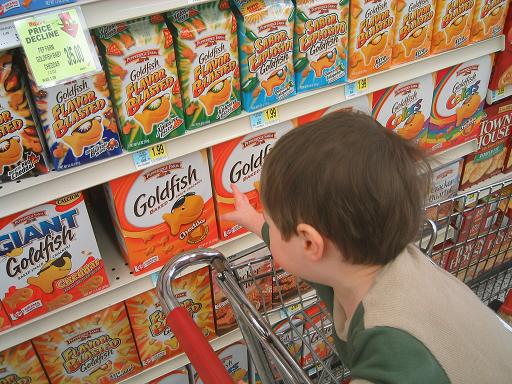My three year old son loves to go to the grocery store with Mom and Dad. He wanders around with us, listening to our discussions about which products to buy, and quite often expresses his own opinions. He’ll remind us that he loves V8 Fusion (our preferred fruit juice, since it’s 100% and also is half vegetable juice) and often dallies for a long time near the Pepperidge Farm goldfish crackers, as I noted two years ago (and depicted as well):

As we shop, we make tons and tons of little decisions along the way. Those decisions, on their own, seem inconsequential.
Should we buy the bulk can of diced tomatoes or the smaller can?
These tortillas feel softer, but they’re way more expensive – is it worth it?
The free range whole chickens are on sale! Should we stock up?
A choice one way or another here might save us a dollar or cause us to spend a dollar more. In the eyes of many people, it’s an inconsequential decision – just make it and keep going. One dollar doesn’t make a huge difference, right?
The problem is that each little buying decision you make is deeply tied to other buying decisions, whether consciously or not.
How so, you might ask?
All of our buying decisions are based on a set of principles in our head, ones that are often so well-grounded that they don’t even pop up in conscious thought.
Here’s a thought experiment to help you see what I mean. Imagine a product you would never buy in a grocery store – pork rinds, maybe, or perhaps insanely potent hot sauce. Now, what about that product would cause you to not buy it? You’re likely to pop up an immediate simple answer – I don’t like the taste or it’s unhealthy – but on other purchases, you’re quite willing to overlook that principle for other reasons.
In truth, when we make a decision to buy in the grocery store, we’re trying to reduce a big set of principles and inputs down to one split-second decision. And often we feel we’re completely justified in that decision – and we move on with life.
It is very easy to tease apart each little buying decision, tell yourself that it doesn’t really matter that much and that it’s okay to splurge, and then essentially ignore your final tally when you get to the checkout because each decision was justified in your mind. Doing that, though, is a game that will, time and time again, put your wallet in the hurt locker.
So, what can you do to overcome this problem?
The easy methods are the shopping list and the meal plan. Making a shopping list in advance of your visit to the grocery store simply serves to reduce the number of decisions you have to make. This, of course, leads you to making fewer bad decisions.
But that’s just the start. Once you’re in the store with your shopping list in hand, commit to three more things.
First, simply do not put anything in your cart that’s not on your list. Your list, if it’s thought out at all, should have everything you need for your meals for the next week. If you see something you feel like you need or deserve, jot it on the back of the list for next time.
Second, mark any items that you’re not simply searching for the cheapest version of. On our list, I like to put a little X by any item that I don’t intend to just buy the cheapest version of. For example, with diced tomatoes, the various brands and cans are identical in terms of ingredients, so we usually just get the cheapest version. This, again, reduces the number of opportunities for poor impulse decisions in the store.
Third, if you have specific brands in mind (because of coupons or because of previous buying experiences), put those on your list, too, along with the size. For example, we usually have a big stack of coupons for V8 Fusion (100% juice, half fruit and half vegetable). So, instead of just writing “fruit juice x 3,” I’ll write “46 oz. V8 Fusion x 3? on the list. In other words, if you make the list more specific, you further reduce the number of potential impulse decisions in the store.
Using all of these techniques, you’ll end up making just a handful of in-the-moment choices in the grocery store – and with fewer potential decisions, you have fewer chances to make poor ones. The end result? A cart full of items that you actually want and a much smaller grocery bill.